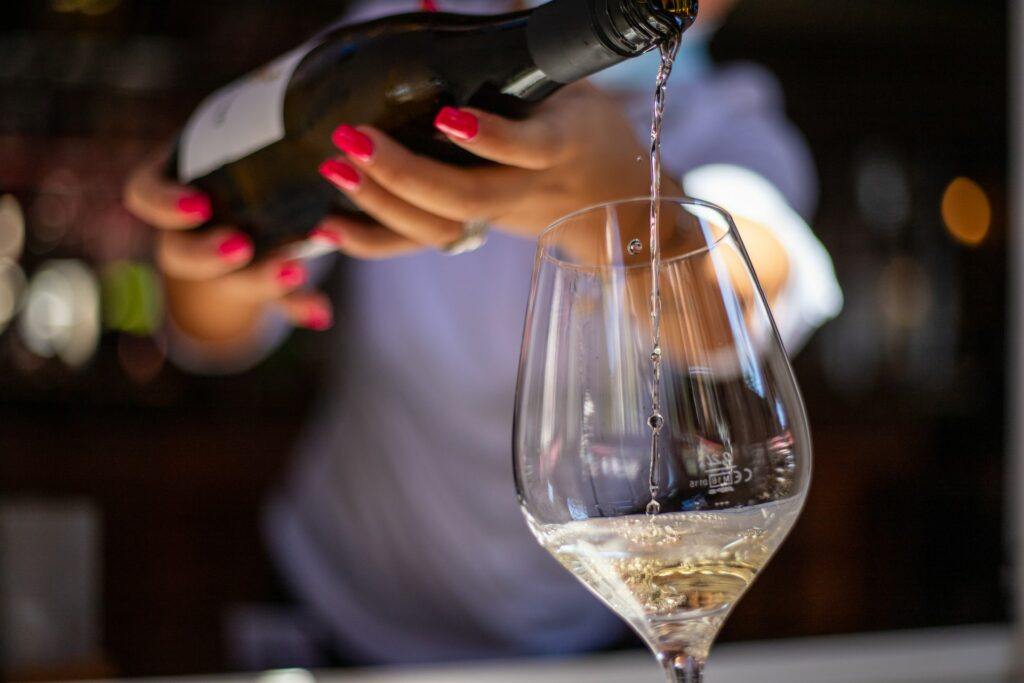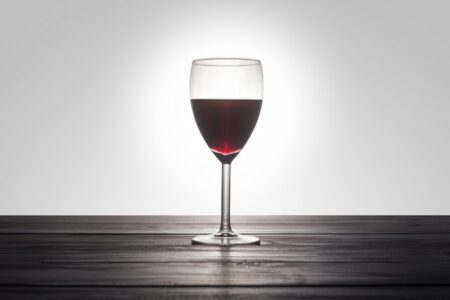When we are at home and decide to enjoy a glass of wine, how much wine goes in the glass? Whether we are pouring to accompany our dinner, or because we love a glass of wine in the evening, does it matter how much we pour in the glass.
I have more than half filled my wine glass on many occasions, as I am sure you have too, be honest. If you know a wine well, then filling the glass near to the top does not really matter, after all you know the wine.
If you are trying a new wine and want to get the most from that wine, then you might want to go easy on how much you fill the glass.
This brings us back to the same question, why are wine glasses filled halfway?
The Demands Of A Wine Glass

The typical wine glass is designed to only be filled halfway, but is this true? No, a wine glass has several features all designed to enhance our experience of a wine and to indicate where to fill to.
The wine glass has a base with a long stem holding a deep bowl that narrows to the rim, that’s a fair description.
The Base
The base has an obvious job, it is there to support the stem and glass above it, and keep the glass upright when you set it down on a table or counter.
The Stem
The stem is your handle, this is where you hold the glass. Holding the stem instead of the glass stops heat from your hand transferring to the wine altering its temperature. It’s important.
The Glass
The glass consists of three elements, or different areas, and they all play their part in the enjoyment of wine. The three elements are the bowl, the headspace and the rim.
The Bowl
This is the part where the wine sits once poured and the wine should not be poured beyond the widest part of the bowl. Beyond the widest part of the bowl, then becomes the headspace.
The Headspace
This is where the wine coats the glass and has space to release aromas for the nose. Having this space allows the wine to be swirled giving room for the nose and less chance of spilling the wine.
The Rim
There is not much to say about the rim, except that this is the part that brings the aroma and flavor to our nose and mouth.
It all depends on the widest part of the bowl. If we only fill the glass to the widest part of the bowl so as to give the headspace room to do its job, and not spill the wine, then how full is that?
It is probably never over half full, but could be less than half, a third or even a quarter of the glass capacity.
Is It Rude To Fill A Wine Glass?

It can be seen as such, socially to fill a wine glass would be unacceptable. You will never see waiting staff filling a wine glass to the top. They are trained to only part fill a wine glass because they know it needs room to be swirled and the aromas enjoyed.
Whether you agree with this or not, and it has always stirred up debates whether there is real science behind it, or whether it is just guff.
In a social environment outside your home, you will find it hard to see a wine glass filled more than halfway. At home on the other hand you fill your glass to where you want to fill it.
As I said, if you know a particular wine well, then there is less need to know its bouquet and sample those aromas. You may fill your glass more than halfway, no one will question you. Even if you are trying a new wine at home you can fill it to where you like, but it is worth giving the swirl and smell thing a chance.
Next time you try a new wine only fill to the widest part of the bowl, give it a good swirl and take in the nose. You may be surprised how it can enhance the flavor and your experience of the wine in general.
What Are Wine Legs?

These are not the legs you get when you have had to many glasses of wine, you know the legs you can’t really trust to hold you up anymore.
There is such a thing as wine legs when it comes to the wine in your glass, who knew wine had legs.
Wine legs are the residue liquid that forms arches and tear type patterns on the inside of your glass. Swirl a glass of wine, which will coat the headspace of your wine glass with wine and watch as it runs down the inside of the glass forming streaks and patterns.
This is said to be the parting of the water and alcohol content in the wine, with the water moving away from the alcohol, this is caused by fluid surface tension.
There is science behind this and it is known as the Marangoni Effect which explains this in more detail, but be warned it goes deep. There are some that say you can tell the quality of wine by the legs, but I am pretty sure there is no real concrete evidence to this claim.
If you want to see wine legs, then swirl your wine in the glass and watch them legs go.
How To Pour Wine

Standard red and white wines are poured differently to sparkling wine (including Champagne), and there are a few things to keep in mind.
A still red or white wine is poured into a wine glass that is set level on a table or counter. The wine is poured into the center of the glass slowly so as not to splash. The rule is to never touch the rim of the glass with the bottle and to turn the bottle (which should have a napkin wrapped around it) in hand between glasses to avoid drips.
Sparkling wine is poured onto the inside wall of the glass which is held at an angle and straightened as the glass fills, this keeps the bubbles and foam to a minimum.
There are wine temperatures to consider too, a red wine which we all tend to serve at room temperature, can be a little too warm. Our homes heating systems can bring our room temperatures above the serving point of the wine.
To serve a wine at room temperature look at between 60 to 65 Fahrenheit (15 – 18 Celsius) for best results.
There are different temperatures for different wines, from desert wine to Champagne, but a general rule is to look between 45 – 60 Fahrenheit (7 – 15 Celsius) for the best results.
These are a few things to consider when you are pouring wine, and of course not to fill your wine past the widest point of the bowl.
The Delights Of Wine

Wine is delightful, whether we know much about it or not, the actual drink is wonderful and we all have our favorites. We don’t have to go to wine school and become an expert to enjoy the taste of wine. Knowing a little can enhance the wine experience, swirling and smelling the aromas from the wine is an example of that.
Filling a wine glass to the widest part of the bowl makes it easy to know where to fill it to, this way you don’t have to judge what is half, what is a third, or what is a quarter fill.
You now know the answer to the question ‘why are wine glasses filled halfway’. I didn’t want to just answer that question and leave it there, so I added a few more wine quirks for you to enjoy. Hopefully there are a few tips that you have learned that will enhance your wine experiences.
Share your thoughts below, but most of all enjoy your wine.
Rob is a passionate home bar and pub shed enthusiast with a passion for craft beer. With hands-on experience in designing and building his own home bar, Rob shares his knowledge, tips, and inspiration to help fellow enthusiasts create their own perfect space. Alongside the world of home bars and pub sheds, Rob also explores the diverse and exciting realm of craft beer, providing honest reviews to help you discover your next favorite brew. Join Rob on a journey of flavor, design, and craftsmanship right here on Home Bar Kit.

